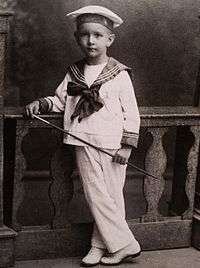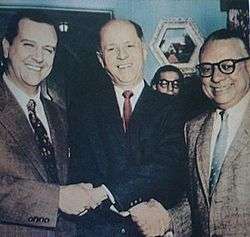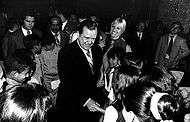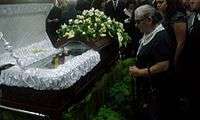Rafael Caldera
| Rafael Caldera | |
|---|---|
 | |
| President of Venezuela | |
|
In office 2 February 1994 – 2 February 1999 | |
| Preceded by | Ramón José Velásquez |
| Succeeded by | Hugo Chávez |
|
In office 11 March 1969 – 12 March 1974 | |
| Preceded by | Raúl Leoni |
| Succeeded by | Carlos Andrés Pérez |
| Senator for Life | |
|
In office 12 March 1974 – 2 February 1994 | |
|
In office 2 February 1999 – 20 December 1999 | |
| President of the Chamber of Deputies of the Congress of Venezuela | |
|
In office 1959–1962 | |
| Solicitor General of Venezuela | |
|
In office 26 October 1945 – 13 April 1946 | |
| Personal details | |
| Born |
Rafael Antonio Caldera Rodríguez 24 January 1916 San Felipe, Yaracuy |
| Died |
24 December 2009 (aged 93) Caracas, Venezuela |
| Political party |
COPEI (1946–1993) National Convergence (1993–2009) |
| Spouse(s) | Alicia Pietri Montemayor |
| Alma mater | Central University of Venezuela |
| Occupation | Lawyer |
| Religion | Roman Catholicism |
| Signature |
|
| Website | Official website |
Rafael Antonio Caldera Rodríguez (Spanish pronunciation: [rafaˈel anˈtonjo kalˈdeɾa roˈðɾiɣes]; 24 January 1916 – 24 December 2009) was a Venezuelan politician who served as the 56th and 63th President of Venezuela from 1969 to 1974 and again from 1994 to 1999.
Caldera taught sociology and law at various universities before entering politics. He was a founding member of COPEI, Venezuela's Christian Democratic party. He first ran for president unsuccessfully in 1947 and tried again every time it was possible until finally succeeding in 1968, winning by a relatively scant 33,000 votes against a recently divided Acción Democrática party. When he was sworn into office in 1969, it marked the first peaceful transfer of power from one party to another in Venezuela's history. During his first presidency, Caldera was able to pacify the country by granting an amnesty that allowed guerrilla fighters, who had been operating clandestinely for almost a decade, to reincorporate into society and participate in politics.
In 1993, Caldera split from COPEI, the party he had founded, to form a new political party, Convergence, which, supported by a coalition of many small leftist parties: (MAS, MEP, PCV) as well as some centre-right parties (URD, MIN), raised Caldera to the presidency in December 1993. This was a fatal blow to the traditional parties which, leaderless and demoralized, garnered few votes in the election. He won a very narrow victory in that year's presidential election. During his second presidential period, he pardoned Hugo Chávez, who eventually went on to succeed him in 1999.
Family and education

Rafael Caldera, was born in San Felipe, Yaracuy. His parents were Tomás Rafael Caldera Izaguirre and Rosa Sofía Rodriguez Rivero. Orphaned at a young age, he was adopted by his aunt Maria Eva Rodriguez Rivero, who was married to lawyer Tomás Liscano,[1] and became part of a wealthy Venezuelan Roman Catholic family. He married Alicia Pietri de Caldera (granddaughter of Juan Pietri, and first-cousins with Arturo Uslar Pietri and Andres Boulton Pietri) in 1941 with whom he had six children: Mireya, Juan José, Rafael Tomás, Alicia Helena, Cecilia, and Andrés Antonio Caldera Pietri.
Caldera attended elementary school in San Felipe 1921–1922, entered San Ignacio school of the Society of Jesus in Caracas 1923–1925, in 1926 returned to Yaracuy studying at Padre Delgado school, and secondary education again in Caracas (San Ignacio school) 1927–1931, made his superior studies in this city, at the Central University of Venezuela (UCV) 1931–1938, obtained a doctorate in the Faculty of Law and Political Sciences; later he was professor of sociology and law in several universities including the UCV, where he was a student leader, which took him into the political world.
Due to his education, Caldera was fluent in languages including French, English, Italian, while being somewhat fluent in German and Portuguese. Caldera was also a leading student on the 19th century humanist and educator Andrés Bello and wrote multiple books on politics, literature and Christian Democracy, and was a member of the Venezuelan Academy of the Language. As such, one of his achievements is the acceptance of millardo ("milliard", 109) by the Royal Spanish Academy in 1995 as an alternative to mil millones (in English: one billion).
Caldera participated in educative and political circles, like the direction of the Venezuelan Institute of Labor rights (1958–1966) and the presidencies of the Venezuelan Association of Sociology (1958–1967), the Christian Democratic Organization of Latin America (1964–1968) and the Christian Democrat International (1967–1968).[2]
Political life
| Part of a series on |
| Christian democracy |
|---|
 |
|

Foundation of several parties, and the beginning of COPEI
Caldera was secretary of the Venezuelan Catholic Youth. In 1936 he participated in the formation of the National Student Union, which on 1 October 1938 became the political party Electoral Action. This party later merged with the National Action Movement, legalized on 2 June 1942, which was one of the groups that formed the social Christian party COPEI on 13 January 1946, with Caldera becoming known as a co-founder of the party. Caldera stood as COPEI's candidate in the 1947 presidential elections, being defeated by the Acción Democrática (AD) candidate, writer Rómulo Gallegos. Gallegos was overthrown a few months later by a military junta, headed by Carlos Delgado Chalbaud, who was later succeeded by the dictatorship of Marcos Pérez Jiménez.[3]
Presidential candidate

After the overthrow of Pérez Jiménez and the consequent constitution of a provisional government headed by Wolfgang Larrazábal in 1958, Caldera was elected Solicitor General of Venezuela, but left this position, to participate in the 1958 Presidential Elections, which were won by Rómulo Betancourt of Acción Democrática. Nevertheless, Caldera had much influence as a leader in his political party, which was the third strongest political force in the country at the time. Together with Betancourt, Jóvito Villalba, leader and founder of Unión Republicana Democrática (URD), and other political leaders, he elaborated and signed the Punto Fijo Pact, (named after Caldera's house, which was the site chosen by the leaders to sign the document). Supporters of the pact claimed that it provided the basis of a democratic coexistence which would hold for the next 40 years, laying the foundations for principles such as free and transparent elections, respect for electoral results, the conformation of checks and balances for the branches of the government, with representation of independent political forces, and the application by those governments of a Common Minimum Program that guaranteed the democratic viability and the development of the country with the due internal consensus.
Caldera was COPEI's unsuccessful candidate for president again in 1963. On his third try in 1968, he took advantage of a split in AD to win with won 29 percent of the vote, finishing 33,900 votes ahead of the AD candidate. However, Venezuela does not have a provision for a runoff election, so this was enough to make Caldera the first president from COPEI. When he was sworn in as president on 11 March 1969, it marked the first time in Venezuela's 139 years of independence that an incumbent government peacefully surrendered power to an elected member of the opposition. However, COPEI still had a minority in the legislature.[4][5]
First term as president (1969–1974)
| Candidates | Votes | % |
|---|---|---|
| Rafael Caldera | 1,083,712 | 29.13% |
| Gonzalo Barrios | 1,050,806 | 28.24% |
| Miguel Angel Burelli | 826,758 | 22.22% |
| Luis Beltran Pietro Figueroa | 719,461 | 19.34% |
| Abstention: | 135.311 | 3.27% |
| Total votes: | 3,999,617 |


Caldera's first government emphasized the end of the Betancourt doctrine, which denied Venezuelan diplomatic recognition to any regime, right or left, that came to power by military force. Caldera broke the isolation of Venezuela with the rest of Latin America, recognized the military governments of the region, and made a policy in defense of the insular territories, and the Gulf of Venezuela, and signed the Port of Spain Protocol with Guyana, which concerned the Guayana Esequiba. The president's economic policies were notable for the reinforcement of the power of the employer's association Fedecámaras, and the period of North American economic crisis, that also characterized the first term of Richard Nixon, with low oil prices, which caused the economic growth of Venezuela to stagnate. Caldera also presided over a period of pacification of the country, making a ceasefire with the left armed groups of FALN, which were then integrated into the political life, and legalising the Communist Party of Venezuela in spite of the opposition of Acción Democrática.
Caldera also reformed the 1961 Constitution to remove a ban on election to public office for people who had been sentenced to more than three years in prison, which had been specifically designed to politically disqualify General Marcos Pérez Jiménez, by means of its retroactive application. Caldera closed the Industrial Technical School permanently, and the Central University of Venezuela for two years, due to student protests against his government. On 9 December 1970, Rafael Caldera created the Great Marshal of Ayacucho Institute of National Higher Defence Studies (IAEDEN), to further the development of a state security perspective, and to contribute to the defence culture of the nation.
Caldera, who raised the tax on the rent to the oil companies to 60 percent, initiated the construction of El Tablazo petrochemical complex, in Zulia State. He also inaugurated the Poliedro de Caracas, the Universidad Simón Bolívar and the Miguel Pérez Carreño Hospital in Caracas, and concluded the demarcation of borders with Brazil. Rafael Caldera ended his first term as president on 12 March 1974, and was replaced by Carlos Andrés Pérez, from Acción Democrática, who won the 1973 elections.[6]
Pacification of Venezuela
In 1969, the new government inherited a country with active urban and rural guerrilla movements, bans on two important political parties and many political leaders imprisoned. From the beginning of Caldera's presidency, this practice was suspended and constitutional guarantees thereafter were maintained.
The government was reported to have an attitude of ideological pluralism and dialogue across the political spectrum, entered into talks with the armed groups, legalized leftist parties and released jailed politicians, demanding only that they stay within Venezuelan law. However, on 3 October 1970, the administration of President Rafael Caldera ordered the Central University of Venezuela (UCV) to be raided by the military and Rector Jesús María Bianco was forced to resign. The University reopened in 1971 with a new Rector and a new plan for renovation. Media was prevented from reporting too many details about the students who were massacred during the raid.
As result from this violent-means effort, by the end of Caldera's presidency, for the first time in many years, no significant political organization in Venezuela planned to threaten the ruling class by attempting to take control of the government by violent means. At the 1973 elections, leaders of the old guerrilla movements who had not died or disappeared and had negotiated with the AD-COPEI consensus, were elected as senators and deputies.[7]
Political activity and leaving COPEI

Caldera waited the ten years of the constitutional period, of no immediate re-election, and stood as a candidate again in the 1983 Presidential Elections with COPEI support, and was defeated by Jaime Lusinchi of Democratic Action (AD). In 1987 stood for the COPEI nomination for the 1988 presidential election, being defeated by Eduardo Fernández. Caldera tried to move Copei to the centre-left in order to fill in the space emptied by AD, but lost the intra-party conflict to Fernández who wanted to continue Copei's traditional centre-right position.[8] In 1993 he decided to leave COPEI, and participated in the presidential elections of the same year with his new party, known as National Convergence, with the support of groups which had been his historical opponents, such as the left parties PCV, MAS and MEP.
| “ | We cannot ask to people with hunger to immolate themselves for a democracy that has not been able to give them enough to eat. | ” |
| — Declarations of Rafael Caldera at the National Congress after the 4 February 1992 coup attempt[9] | ||
Caldera won his second term as president in February 1994 – a win with its roots in his speech to the National Congress on 4 February 1992, the date of the first failed coup d'état against the second government of Carlos Andrés Pérez. His tacit support to the Caracazo in 1989, the 1992 coup attempts led by Hugo Chávez, and the opposition to the neoliberal economic reforms pursued by Pérez in his second term, mark the beginning of Caldera's return to the presidency for a second term. Caldera won with around 30% of the votes, followed very closely by three other candidates, but the abstention rate was 39.84%. Caldera could benefit from centrist and centre-left voters who did not feel represented by any of the traditional parties. He performed much better than Copei's candidate Oswaldo Álvarez Paz.[8]
Second term as president (1994–1999)
In his second presidency, Caldera included politicians from other political backgrounds who supported his candidacy in his cabinet, like some representatives of MAS party, Teodoro Petkoff at the Ministry of the Central Office of Coordination and Planning, and Pompeyo Márquez at the Border Ministry, as well as some independents in other ministries. The support of the MAS and other parties were fundamental to approve some laws in the National Congress in his first years of government, due to his own party having few seats in Congress. On 18 December 1994 he inaugurated the Plaza Venezuela – El Valle section of the Caracas Metro which had been initiated by previous governments. In 1996, he received Pope John Paul II on his second visit to Venezuela, when he blessed the prisoners of the Catia Prison, on the west side of Caracas (After this visit, the building was demolished).[10] On 12 October 1997 he received U.S. President Bill Clinton, in November of the same year Margarita Island hosted the Seventh Ibero-American Conference. In June 1998, the Inaugural meeting of the XXVIII General Assembly of the Organization of American States was held in Caracas.[11]
Economic crisis
In the first year of his second presidency, Caldera was faced with a major financial crisis (Venezuelan banking crisis of 1994) that began with the failure of Banco Latino during the acting presidency of Ramón José Velásquez, continued with the failure of more than ten banks, and culminated with the loss of deposits. Necessary financial aid granted by the government to the banks curtailed government spending in other areas, affecting thousands of people and creating a serious imbalance in the Venezuelan economy.
| Candidates | Votes | % |
|---|---|---|
| Rafael Caldera | 1,710,722 | 30.46% |
| Claudio Fermín | 1,325,287 | 23.60% |
| Oswaldo Alvarez Paz | 1,276,506 | 22.73% |
| Andrés Velásquez | 1,232,653 | 21.95% |
| Abstention: | 3,859,579 | 39.84% |
| Total votes: | 5,829,216 |
The confidence and credibility of Venezuelans and foreigners at the financial institutions were affected seriously. More than seventy thousand medium and small companies went bankrupt, fundamentally due to the exchange rate regime imposed by the government, which made it difficult to obtain the currency to acquire intermediate goods. The prices of food, clothes and transport rose without control, impoverishing a greater number of Venezuelans.
Caldera also had to handle a vertiginous inflationary spiral and a parallel reduction of the Forex reserves, employees generously for the support of the bolívar in front of the U.S. dollar. On 27 June, he announced the temporary suspension of some constitutional guarantees, fundamentally related to the private property and the free economic activity, to allow control of the exchange market, the banking system and prices by the State. The financial organizations bankrupted by the draining of deposits and those affected by speculative practices went to be adjusted by the State. The Central Bank of Venezuela announced the suspension of all of its transactions in dollars.
Although Caldera promised during his campaign never to accept the help of the International Monetary Fund, his government rescinded the vow due to the economic crisis. The effect of the interventionist on the economy of Venezuela led Caldera to announce the Agenda Venezuela (Venezuela Agenda) programme, which promised to restore the macroeconomic balance and to beat inflation. He applied measures labeled by his opponents as neoliberal, in agreement with the recommendations of the IMF. The bolívar was devalued by 70%, the exchange rate regime was imposed, fuel prices were increased by 800%, rates of interest were liberalized, and the process of privatization was continued. His program was welcomed by the IMF, but not by the populace. Demonstrations and disturbances were frequent.
In 1997, a tripartite commission, consisting of representatives of industrialists, workers and the Government, assumed the reform of the regime of social benefits, and the deep revision of the labor law. The tripartite commission created a system of social benefits.
Apertura Petrolera was adopted to increase involvement of the private sector and international oil companies in the operation, exploration and refinement of petroleum and natural gas. The worldwide oil market crisis negatively influenced this process.
Due to differences with his coalition partners such as MAS, Caldera looked for the support of AD in Congress. Some AD members entered the Ministerial cabinet.[13]
Dismissal of Charges to the 1992 coup participants
In 1994 Caldera fulfilled a promise made during the presidential campaign, by pardoning and dismissing the charges against the military figures involved in the 1992 Venezuelan coup d'état attempt,[14] giving them full political rights and making it impossible to try them on any charges related to their armed movement, including the deaths of more than 200 people as a direct consequence of the failed coup. According to General Carlos Julio Peñaloza, both Caldera and Fidel Castro knew of Chávez's 1992 coup attempt, with Castro placing agents near then President Pérez, convincing him there was not a threat of a coup, while Caldera was meant to assume the role of the president after Pérez was supposed to be assassinated.[15]
Many of the military figures, once liberated, grouped in the MVR political party, under the leadership of Hugo Chávez, who ultimately, after several years in the political wilderness, won the 1998 presidential elections. That election saw the comprehensive defeat of Acción Democrática and COPEI, which had alternated in government for 35 years (from 1959 to 1994), and which now lost their influence on the Venezuelan political scene.
Personal life
Caldera was married to Alicia Pietri Montemayor, who served as First Lady of Venezuela from 1969–1974, and 1994–1999.
Last years and death

On 2 February 1999, Rafael Caldera concluded his second term as president and was succeeded by Hugo Chávez. Although Caldera granted Chávez amnesty and his release from prison in March 1994, Chávez criticized Caldera in his inaugural speech. After the parliamentary elections of 30 July 2000, National Convergence remained with a single representative in the new unicameral National Assembly until 2005.
His poor health caused by Parkinson's disease forced him to retire from politics during his last years.[16] Caldera died around 2 a.m. on 24 December 2009 at the age of 93.[17][18][19] His son Andrés Caldera announced the death, but did not specify a cause.[14][18][20] His funeral was on 26 December 2009, in Caracas.[17] He was buried the same day.[21]
Bibliography
- Andrés Bello (1935)
- Derecho del Trabajo (1939)
- Idea de una sociología venezolana (1953)
- Aspectos sociológicos de la cultura en Venezuela (1957)
- El Bloque Latinoamericano (1961)
- Moldes para la Fragua (1962)
- El lenguaje como vinculo social y la integración latinoamericana (1967)
- Especificidad de la Democracia Cristiana (1972)
- La Solidaridad Pluralista de América Latina (1973)
- La Casa de Bello (1973)
- Temas de Sociología Venezolana (1973)
- Cinco años de cambio (1974)
- La Nacionalización del Petróleo (1975)
- Reflexiones de la Rábida (1976)
- Caracas, Londres, Santiago de Chile: las tres etapas de la vida de Bello (1981)
- Parlamento Mundial: una voz latinoamericana (1984)
- Bolívar Siempre (1987)
- El pensamiento jurídico y social de Andrés Bello (1987)
- Los causahabientes, de Carabobo a Puntofijo (1999)
- La Parábola vital de Rómulo Betancourt (2002)
- La Venezuela Civil, constructores de la república (2014; posthumous)
- Los desafíos a la gobernabilidad democrática (2014; posthumous)
- Justicia Social Internacional (2014; posthumous)
- Frente a Chávez (2015; posthumous)
Honours
-
 Argentina : Order of the Liberator General San Martin
Argentina : Order of the Liberator General San Martin -
 Lithuania : Grand Cross of the Order of Vytautas the Great (7 March 1996) [22]
Lithuania : Grand Cross of the Order of Vytautas the Great (7 March 1996) [22]
See also
References
- ↑ Guillermo Morón, "Los Presidentes de Venezuela". Caracas: Meneven, 1979
- ↑ Family and education
- ↑ Foundation of several parties, and the beginning of COPEI
- ↑ Presidential candidate
- ↑ "Político y estadista venezolano del Siglo XX. Ex-Presidente de la República. Biografía. Selección de discursos políticos. Himno Nacional de la República Bolivariana de Venezuela". Fundacionjoseguillermocarrillo.com. Retrieved 2010-12-27.
- ↑ First term as president
- ↑ Pacification of Venezuela
- 1 2 Seawright, Jason (2012), Party-System Collapse: The Roots of Crisis in Peru and Venezuela, Stanford University Press, p. 167
- ↑ "Dos discursos" (PDF). rafaelcaldera.com. Retrieved 9 June 2016.
- ↑ Second term as president
- ↑ Foreign policy
- ↑ Archived 17 June 2006 at the Wayback Machine.
- ↑ Economic Crisis
- 1 2 Efrain Hernandez Jr. (24 December 2009). "Former Venezuela President Rafael Antonio Caldera dies at age 93". The Los Angeles Times. Retrieved 2009-12-24.
- ↑ Maria Delgado, Antonio (16 February 2015). "Libro devela sangriento objetivo de la intentona golpista de Hugo Chávez". El Nuevo Herald. Retrieved 17 February 2015.
- ↑ Later trajectory
- 1 2 "Venezuelan ex-President Rafael Caldera dies at 93". Yahoo! News. Archived from the original on 26 December 2009. Retrieved 2009-12-24.
- 1 2 "Rafael Caldera, Ex-President of Venezuela, Dies at 93". The New York Times. 24 December 2009. Retrieved 2009-12-24.
- ↑ "Ex-Venezuelan president dies". The Straits Times. 25 December 2009. Retrieved 2009-12-25.
- ↑ Murió el expresidente Rafael Caldera. Globovision, December 24, 2009
- ↑ "Two-time Venezuelan president Caldera dies at 93". Reuters. 24 December 2009. Retrieved 2009-12-24.
- ↑ Lithuanian Presidency website, search form
External links
| Wikimedia Commons has media related to Rafael Caldera. |
- (Spanish) Rafael Caldera — Official biography.
- (Spanish) Rafael Caldera — Biography from National Convergence webpage.
- (Spanish) Speeches and Biography
- (Spanish) Extended bio by CIDOB Foundation
- (Spanish) Interview to Rafael Caldera (RCTV, 19 September, 1993) - YouTube
- (Spanish) Rafael Caldera´s message to Venezuelan Youth in 1998 on YouTube
- Rafael Caldera — Daily Telegraph obituary
| Party political offices | ||
|---|---|---|
| Preceded by — Luis Herrera Campins (1978) |
COPEI presidential candidate 1947 (lost) 1958 (lost) 1963 (lost) 1968 (won) 1983 (lost) |
Succeeded by Lorenzo Fernánndez (1973) Eduardo Fernández (1988) |
| Preceded by — |
National Convergence presidential candidate 1993 (won) |
Succeeded by — |
| Political offices | ||
| Preceded by Raúl Leoni |
President of Venezuela 1969 – 1974 |
Succeeded by Carlos Andrés Pérez |
| Preceded by Ramón J. Velásquez |
President of Venezuela 1994 – 1999 |
Succeeded by Hugo Chávez |
